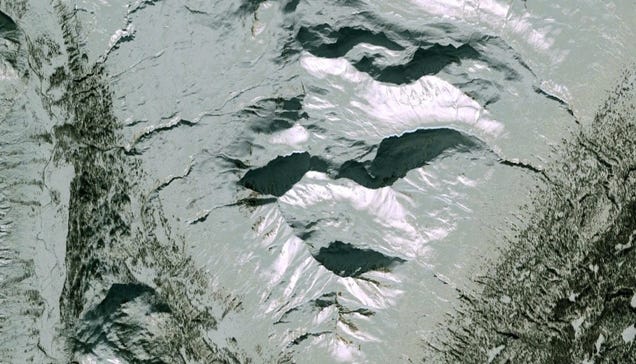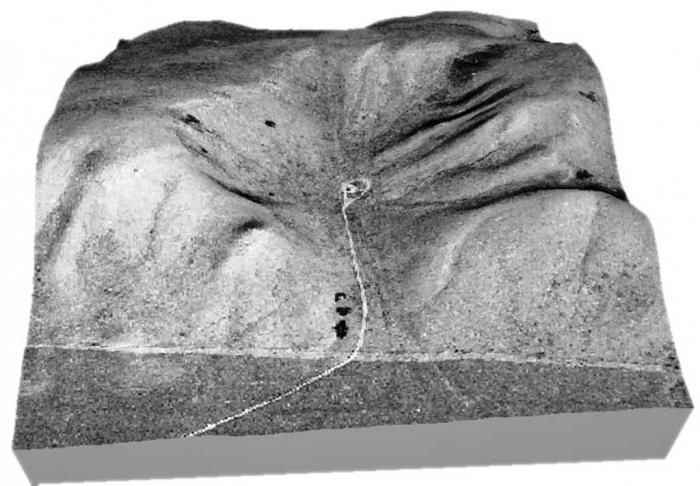
One of many formations in Cydonia, this one is sometimes called the "D & M pyramid". Similar optical illusions can be found in the geology of Earth examples include the Old Man of the Mountain, the Romanian Sphinx, the Pedra da Gávea, the Old Man of Hoy, Stac Levenish, and the Badlands Guardian. After analysis of the higher resolution Mars Global Surveyor data NASA stated that "a detailed analysis of multiple images of this feature reveals a natural looking Martian hill whose illusory face-like appearance depends on the viewing angle and angle of illumination". Since it was originally first imaged, the face has been accepted by scientists as an optical illusion, an example of the psychological phenomenon of pareidolia. By combining data from the High Resolution Stereo Camera (HRSC) on the Mars Express probe and the Mars Orbiter Camera (MOC) on board NASA's Mars Global Surveyor it has been possible to create a three-dimensional representation of the "Face on Mars". For instance, the Mars Express images are at a resolution of 14 m/pixel (46 ft/pixel) or better. In contrast to the relatively low resolution of the Viking images of Cydonia, these new platforms afford much improved resolution.

These spacecraft have included NASA's Mars Global Surveyor (1997–2006) and Mars Reconnaissance Orbiter (2006–), and the European Space Agency's Mars Express probe (2003–). More than 20 years after the Viking 1 images were taken, a succession of spacecraft visited Mars and made new observations of the Cydonia region.

DiPietro and Molenaar discovered the two misfiled images, Viking frames 035A72 and 070A13, while searching through NASA archives. This latter discovery was made independently by Vincent DiPietro and Gregory Molenaar, two computer engineers at NASA's Goddard Space Flight Center. However, a second image, 070A13, also shows the "face", and was acquired 35 Viking orbits later at a different sun-angle from the 035A72 image. When the image was originally acquired, Viking chief scientist Gerry Soffen dismissed the "Face on Mars" in image 035A72 as a "trick of light and shadow". In one of the images taken by Viking 1 on July 25, 1976, a two-kilometre-long (1.2 mi) Cydonian mesa, situated at 40.75° north latitude and 9.46° west longitude, had the appearance of a humanoid face.

Of the seven good images, the lighting and time at which two pairs of images were taken are so close as to reduce the number to five distinct images. The other eleven images have resolutions that are worse than 550 m/pixel (1800 ft/pixel) and are of limited use for studying surface features. Eighteen images of the Cydonia region were taken by the orbiters, of which seven have resolutions better than 250 m/pixel (820 ft/pixel).

Ĭydonia was first imaged in detail by the Viking 1 and Viking 2 orbiters.
#Badlands guardian on mars license
MIDDLE-EARTH, THE LORD OF THE RINGS: THE FELLOWSHIP OF THE RING, THE LORD OF THE RINGS: THE TWO TOWERS, THE LORD OF THE RINGS: THE RETURN OF THE KING and the names of the characters, items, events and places therein are trademarks of The Saul Zaentz Company d/b/a Middle-earth Enterprises under license to New Line Productions, Inc.1976 Viking Orbiter image (left, image #070A13) compared with the 2001 Mars Global Surveyor image (right). THE HOBBIT: AN UNEXPECTED JOURNEY, THE HOBBIT: THE DESOLATION OF SMAUG, THE HOBBIT: THE BATTLE OF THE FIVE ARMIES and the names of the characters, items, events and places therein are trademarks of The Saul Zaentz Company d/b/a Middle-earth Enterprises under license to New Line Productions, Inc. GW, Games Workshop, Citadel, White Dwarf, Space Marine, 40K, Warhammer, Warhammer 40,000, the ‘Aquila’ Double-headed Eagle logo, Warhammer Age of Sigmar, Battletome, Stormcast Eternals, and all associated logos, illustrations, images, names, creatures, races, vehicles, locations, weapons, characters, and the distinctive likenesses thereof, are either ® or ™, and/or © Games Workshop Limited, variably registered around the world.


 0 kommentar(er)
0 kommentar(er)
